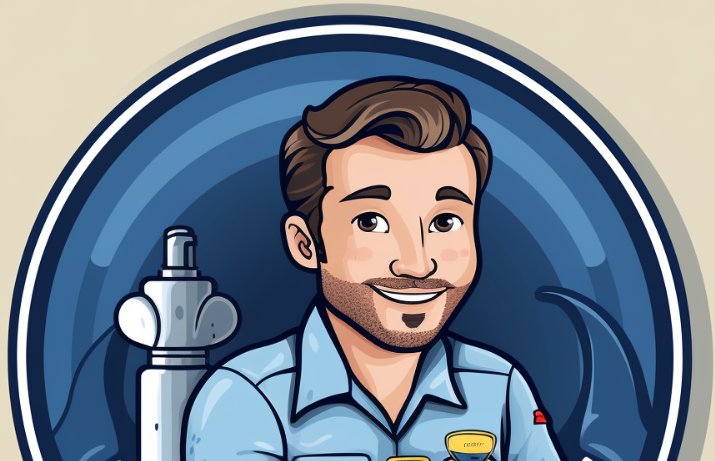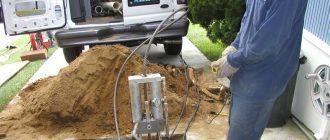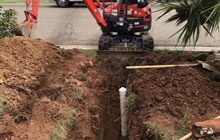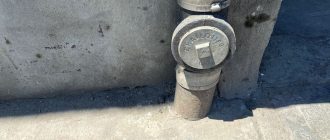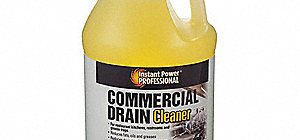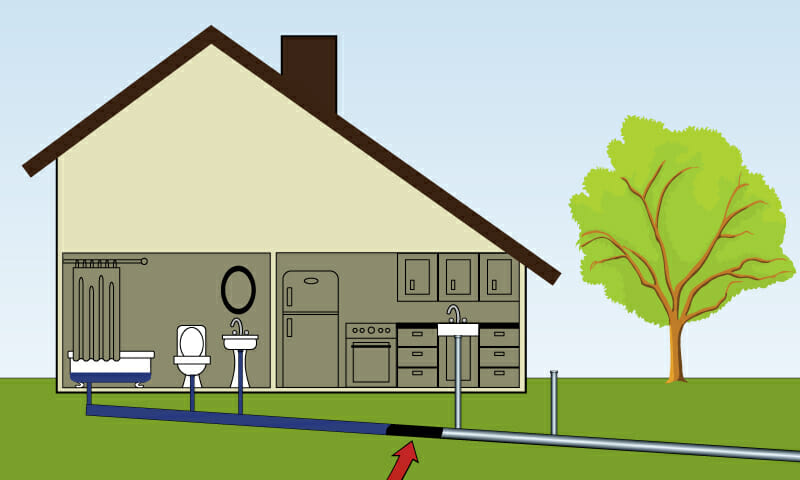
Preventing and resolving drain and sewer line stoppages
Are you tired of dealing with pesky sewer line stoppages? Do you find yourself constantly battling clogged drains and backed up sewer pipes? Look no further! Our expert team is here to help!
Sewer line installation can be a complex and overwhelming process. However, with our professional guidance and expertise, you can rest assured that your sewer system will function flawlessly.
When it comes to dealing with drain and sewer line stoppages, it’s important to know the causes and effective solutions. Ignoring the problem can lead to more serious issues, such as sewage backups and costly repairs. That’s why we’ve put together some essential tips to help you tackle these problems head-on.
Tip #1: Regular maintenance is key. By scheduling routine inspections and cleanings, you can prevent blockages before they become major headaches. Our team of skilled technicians uses advanced equipment to identify any potential issues and ensure optimal flow.
Tip #2: Be mindful of what you put down your drains. Avoid pouring grease, oil, or food scraps down the sink, as they can build up and cause clogs. Use drain screens to catch hair and other debris before they make their way into your sewer pipes.
Tip #3: Invest in high-quality sewer line cleaning products. These specially formulated solutions break down stubborn blockages and maintain the health of your sewer system. They are a cost-effective alternative to expensive plumbing services.
Tip #4: If all else fails, don’t hesitate to call in the professionals. Our experienced team has the knowledge and expertise to resolve even the toughest sewer line stoppages. We offer prompt and efficient service, ensuring minimal disruption to your daily routine.
Don’t let drain and sewer line stoppages ruin your day. Contact us today to learn more about our comprehensive sewer line installation and repair services. Trust our team to provide the best solutions for your plumbing needs!
Causes of Drain and Sewer Line Stoppages
Drain and sewer line stoppages can be caused by various factors, which can lead to inconvenience and costly repairs. Understanding the causes of these stoppages can help homeowners prevent them and maintain a smooth-flowing drainage system. Here are some common causes of drain and sewer line stoppages:
| Belly in Sewer Line | A belly in the sewer line occurs when a section of the pipe sags or becomes misaligned, creating a low point where waste and debris can accumulate. This can eventually lead to a complete blockage, causing backups and slow drains. |
| Sewer Line Installation | Inadequate installation of sewer lines can result in various problems, including stoppages. If the lines are not properly aligned, have incorrect slope or are poorly connected, it can cause waste and debris to accumulate and result in frequent clogs and backups. |
It is important to address these causes promptly to prevent further damage and costly repairs. Regular maintenance and inspections by professional plumbers can help identify and resolve these issues before they escalate.
By understanding the common causes of drain and sewer line stoppages, homeowners can take proactive measures to prevent them. Regular cleaning, proper disposal of waste, and hiring a professional plumber for installation and maintenance can go a long way in maintaining a healthy and functional drainage system.
Symptoms of Drain and Sewer Line Stoppages
If you suspect that you have a drain or sewer line stoppage, it’s important to be aware of the following symptoms:
| Belly in Sewer Line | A belly in the sewer line occurs when a section of the pipe sags or dips, creating a low point where debris and waste can accumulate. This can lead to clogs and blockages, causing slow draining or complete backups in your plumbing system. |
| Sewer Pipes | Blocked or damaged sewer pipes can cause a variety of issues, including foul odors, gurgling sounds coming from drains or toilets, and water backup in sinks, showers, or toilets. If you notice any of these symptoms, it’s important to address the issue as soon as possible to prevent further damage to your plumbing system. |
Identifying and addressing drain and sewer line stoppages early on can help prevent costly repairs and potential health hazards. If you experience any of these symptoms, it is recommended to consult a professional plumber to assess and resolve the issue.
Preventing Drain and Sewer Line Stoppages
Keeping your drains and sewer lines flowing smoothly is essential for a well-functioning plumbing system. By taking proactive measures, you can prevent many common issues such as clogs and blockages. Here are some tips to help you maintain a healthy drain and sewer system:
- Watch what you flush: Avoid flushing anything other than toilet paper down the toilet. Items such as wipes, feminine hygiene products, and paper towels can easily cause blockages in your sewer pipes.
- Dispose of grease properly: Pouring cooking oil or grease down the drain may seem convenient, but over time, it can harden and cause a belly in the sewer line. Instead, allow grease to cool and solidify, then throw it in the trash.
- Use drain screens: Installing drain screens in your sinks and showers can catch hair, soap scum, and other debris before they enter your drain pipes. This can help prevent clogs and reduce the risk of sewer line stoppages.
- Maintain your sewer pipes: Regular sewer line inspections and maintenance can help identify potential issues before they become major problems. A professional plumber can use specialized tools to check for signs of a belly in the sewer line or any other abnormalities.
- Be cautious with landscaping: When planting trees or shrubs near your sewer lines, consider their root systems. Some plants have invasive root systems that can infiltrate your pipes and cause blockages. It’s always best to consult with a professional landscaper or plumber before planting near sewer lines.
- Educate your household: Teach your family members about proper garbage disposal habits. Emphasize the importance of only flushing toilet paper and remind them to avoid pouring grease or other potentially harmful substances down the drain.
- Schedule regular professional inspections: Even if you’re not experiencing any issues with your drain or sewer lines, it’s a good idea to have a professional plumber inspect them on a regular basis. They can identify any potential problems and provide solutions before they lead to major stoppages.
Following these preventative measures can help you avoid costly repairs and keep your drain and sewer lines running smoothly. Remember, a little maintenance can go a long way in preserving the overall health of your plumbing system.
DIY Solutions for Drain and Sewer Line Stoppages
Dealing with drain and sewer line stoppages can be a frustrating and messy experience. However, with the right knowledge and a little bit of elbow grease, you can solve these issues on your own without having to call a professional plumber. Here are some DIY solutions to help you tackle drain and sewer line stoppages:
1. Use a Plunger
If you’re dealing with a clogged drain, a plunger can be a handy tool to have on hand. Make sure you have a plunger that is designed for sink or toilet use, depending on where the blockage is. Use the plunger in an up-and-down motion to create suction and dislodge the clog. Be sure to cover the drain completely and create a tight seal before plunging.
2. Try a Drain Snake
If the plunger doesn’t do the trick, you can try using a drain snake or auger. A drain snake is a long, flexible wire with a small hook at the end. Insert the snake into the drain and twist it while pushing it further into the pipe. This will help break up the clog and allow water to flow freely again.
3. Use Baking Soda and Vinegar
A natural and environmentally friendly solution for clearing drain and sewer line stoppages is to use a combination of baking soda and vinegar. Start by pouring about a cup of baking soda into the drain, followed by a cup of vinegar. Let the mixture sit for about half an hour, then flush it with hot water. The chemical reaction between the baking soda and vinegar helps to dissolve the clog and clear the pipes.
4. Clean the Sewer Pipes
If you’re experiencing recurring sewer line stoppages, it may be time to clean the pipes. This can be done by removing the P-trap under the sink and clearing out any debris or buildup. You can also use a sewer snake or hire a professional to perform a sewer line cleaning. Regular maintenance and cleaning can help prevent future clogs and keep your sewer system running smoothly.
Remember, if these DIY solutions don’t work or if you’re uncomfortable performing these tasks on your own, it’s always best to call a professional plumber. They have the knowledge and tools to handle more complex drain and sewer line stoppages, as well as perform sewer line installations if needed.
When to Call a Professional for Drain and Sewer Line Stoppages
While there are many do-it-yourself solutions for dealing with drain and sewer line stoppages, there are certain situations where it is best to call a professional. If you encounter a belly in your sewer line, where the pipe sags and collects debris, it is crucial to seek professional assistance. Attempting to fix this issue yourself can result in further damage to the line and potentially costly repairs.
In addition, if you are considering sewer line installation, it is highly recommended to hire a professional. Installing a sewer line requires specialized knowledge and equipment to ensure proper installation and prevent future problems. A professional will have the expertise to assess the terrain, determine the optimal route for the sewer line, and ensure it meets all necessary codes and regulations.
Furthermore, if you have tried various DIY methods to clear a stubborn drain or sewer line stoppage with no success, it is time to call in a professional. They will have access to advanced tools and techniques, such as hydro jetting or sewer line camera inspections, to accurately diagnose and resolve the issue.
Remember, attempting to tackle complex drain and sewer line stoppages without the proper experience and tools can lead to more extensive damage and costly repairs. It is always best to consult a professional for these types of problems to ensure a timely and effective solution.
Common Tools for Drain and Sewer Line Stoppages
Dealing with drain and sewer line stoppages can be a challenging task, but with the right tools, you can easily tackle the problem. Here are some common tools that are essential for resolving drain and sewer line stoppages:
1. Drain Snakes: Drain snakes, also known as augers, are versatile tools used to clear blockages in drains and sewer lines. They consist of a long flexible cable with a coiled metal tip that can be inserted into the pipe. By rotating the handle, the snake breaks up the clogs and allows the water to flow freely.
2. Plungers: Plungers are a must-have tool for any homeowner. They are effective in clearing simple clogs in drains and sewer lines. Plungers work by creating a vacuum seal and exerting pressure to dislodge the blockages. Choose a plunger with a large cup size for more effective results.
3. Sewer Cameras: Sewer cameras are invaluable tools for identifying the cause of a sewer line stoppage. These small, waterproof cameras are attached to a flexible cable and can be inserted into the pipe. By viewing the footage on a monitor, you can identify any issues such as a belly in the sewer line or a collapsed pipe.
4. Hydro-Jetters: Hydro-jetting is a powerful technique used to clear stubborn clogs in sewer lines. Hydro-jetters use high-pressure water streams to break up the blockages and flush them out of the pipe. This method is particularly effective for removing grease, tree roots, and other debris that may be causing the stoppage.
5. Trenchless Sewer Line Installation Tools: If you’re facing frequent sewer line stoppages or need to replace your sewer line, consider using trenchless sewer line installation tools. These tools eliminate the need for extensive digging and disruption to your landscape. Tools like pipe-bursting equipment and pipe-lining systems can install new sewer lines without the need for excavation.
With these common tools at your disposal, you can effectively deal with drain and sewer line stoppages. However, it’s important to exercise caution and seek professional help if you’re unsure about using any of these tools. Remember to always prioritize safety and follow the manufacturer’s instructions.
Chemical Solutions for Drain and Sewer Line Stoppages
When it comes to dealing with drain and sewer line stoppages, sometimes a little extra help is needed. While there are many different methods available, one effective solution is to use chemical drain cleaners. These powerful products are specifically designed to break down clogs and clear blockages in your sewer line, allowing for smooth water flow once again.
Chemical drain cleaners are typically made up of a combination of strong chemicals, such as sodium hydroxide or sulfuric acid. These substances work by reacting with and dissolving the organic matter that causes clogs in your sewer line. When poured down the drain, the chemicals penetrate the clog, breaking it up and clearing the way for water to flow freely.
Using chemical drain cleaners can be a quick and easy way to address minor clogs and stoppages in your sewer line. However, it is important to follow the instructions carefully and take proper safety precautions. Always wear gloves and protective eyewear when handling these chemicals, and never mix different types of drain cleaners together.
It is also worth noting that chemical drain cleaners are not suitable for all types of clogs or stoppages. In some cases, such as a belly in the sewer line or a blockage caused by tree roots, a more extensive solution may be necessary, such as sewer line installation or professional sewer cleaning services.
Before using chemical drain cleaners, it is advisable to try other methods, such as using a plunger or a plumbing snake, to see if the clog can be cleared without the need for chemicals. If these methods do not work, then chemical drain cleaners can be a viable option to consider.
- Make sure to read and follow the instructions on the product label.
- Pour the recommended amount of chemical drain cleaner into the drain.
- Allow the product to sit for the recommended amount of time before flushing with hot water.
- Repeat the process if necessary.
Remember to always use chemical drain cleaners responsibly and as a last resort. If you are unsure about using these products or if your sewer line stoppage persists, it is best to consult a professional plumber who can provide expert advice and assistance.
Hydro Jetting for Drain and Sewer Line Stoppages
When it comes to dealing with stubborn drain and sewer line stoppages, hydro jetting is an effective solution that can help you get rid of even the most stubborn clogs. Hydro jetting involves using high-pressure water to clean out the pipes and remove any buildup or blockages that may be causing the stoppage.
One common cause of drain and sewer line stoppages is a belly in the sewer line. A belly is a sag or dip in the sewer line that can collect debris and cause clogs. Hydro jetting can help to remove this debris and restore the proper flow of wastewater.
Another instance where hydro jetting can be beneficial is during sewer line installation. Before the new sewer line is connected to the main sewer system, it is important to make sure that the line is clean and free of any debris or obstructions that could cause future stoppages. Hydro jetting can effectively clean the new sewer line and ensure that it is ready for use.
Hydro jetting is a non-invasive and environmentally friendly method of unclogging drain and sewer lines. It does not require the use of harsh chemicals and can be used on both residential and commercial properties.
Overall, hydro jetting is a powerful solution for dealing with drain and sewer line stoppages. Whether you are dealing with a stubborn clog or need to clean a new sewer line, hydro jetting can effectively remove blockages and restore proper flow. Contact a professional plumber to learn more about how hydro jetting can benefit your drainage system.
Trenchless Sewer Repair for Drain and Sewer Line Stoppages
When it comes to dealing with drain and sewer line stoppages, one of the most effective and efficient methods of repair is trenchless sewer repair. Traditional methods of repairing sewer pipes would involve digging up the ground to access the damaged pipe, causing disruption to the property and expensive repairs.
However, with trenchless sewer repair, the need for extensive excavation is eliminated. This innovative technology allows for the repair of sewer pipes without the need for digging trenches, which can save homeowners both time and money.
One common issue that can lead to drain and sewer line stoppages is a belly in the sewer line. A belly occurs when a section of the sewer pipe sags, creating a low point where debris and wastewater can accumulate, leading to blockages and backups. Trenchless sewer repair can effectively address and fix this issue without the need for extensive digging.
Using specialized equipment, a flexible liner can be inserted into the damaged sewer pipe. The liner is then inflated and cured in place to create a new, seamless pipe within the existing damaged pipe. This process effectively eliminates any bellies in the sewer line and restores proper flow and function.
Benefits of trenchless sewer repair include:
- Minimal disruption to the property
- Reduced cost compared to traditional excavation methods
- Quicker repair time
- Durable and long-lasting results
- Environmentally-friendly solution
Whether you’re dealing with a minor drain clog or a major sewer line stoppage, trenchless sewer repair is a reliable and efficient solution. Contact our team of professionals today to learn more about how trenchless sewer repair can help resolve your drain and sewer line stoppage issues.
Don’t let drain and sewer line stoppages disrupt your life any longer. Take advantage of the benefits of trenchless sewer repair and get your plumbing system back to optimal performance in no time.
Regular Maintenance Tips for Drain and Sewer Line Stoppages
Regular maintenance is crucial for preventing and addressing drain and sewer line stoppages. By following these tips, you can keep your lines clear and prevent costly repairs:
| 1 | Inspect the sewer line regularly |
| 2 | Look out for signs of a belly in the sewer line |
| 3 | Clear debris and buildup from drains |
| 4 | Use drain strainers to prevent hair and other solids from entering the drain |
| 5 | Avoid pouring grease, oil, and other fats down the drain |
| 6 | Flush the drains with hot water regularly to remove any buildup |
| 7 | Consider professional sewer line cleaning every few years |
| 8 | Ensure proper sewer line installation to prevent future issues |
By incorporating these regular maintenance tips into your routine, you can significantly reduce the risk of drain and sewer line stoppages and save yourself from expensive repairs in the long run.
Q&A:
What are some common causes of drain and sewer line stoppages?
Some common causes of drain and sewer line stoppages include buildup of grease and debris, tree roots infiltrating the pipes, and foreign objects that have been flushed down the toilet or drained.
What are some signs that I may have a drain or sewer line stoppage?
Some signs of a drain or sewer line stoppage include slow draining sinks or toilets, gurgling sounds coming from the drains, foul odors emanating from the drains, and backups or overflows in the plumbing fixtures.
Can I try to clear a drain or sewer line stoppage myself?
Yes, there are some DIY methods you can try to clear a drain or sewer line stoppage yourself. These include using a plunger, a drain snake, or a chemical drain cleaner. However, if the blockage persists or if you are unsure of what to do, it is recommended to call a professional plumber.
How much does it typically cost to clear a drain or sewer line stoppage?
The cost of clearing a drain or sewer line stoppage can vary depending on the severity of the blockage and the location of the problem. On average, you can expect to pay anywhere from $100 to $500 for professional drain cleaning services. However, more complex issues such as tree root removal or pipe repairs can cost significantly more.
Are there any preventive measures I can take to avoid drain and sewer line stoppages?
Yes, there are several preventive measures you can take to avoid drain and sewer line stoppages. These include regularly flushing the drains with hot water, avoiding flushing non-flushable items down the toilet, and being mindful of what you put down the drains (such as grease, food scraps, and hair).
What are the common causes of drain and sewer line stoppages?
Common causes of drain and sewer line stoppages include tree root infiltration, grease buildup, foreign objects, and structural issues.
How can I prevent drain and sewer line stoppages?
To prevent drain and sewer line stoppages, you can avoid pouring grease down the drain, use drain strainers to catch hair and other debris, and have regular inspections and maintenance performed by a professional plumber.
